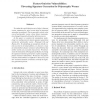Free Online Productivity Tools
i2Speak
i2Symbol
i2OCR
iTex2Img
iWeb2Print
iWeb2Shot
i2Type
iPdf2Split
iPdf2Merge
i2Bopomofo
i2Arabic
i2Style
i2Image
i2PDF
iLatex2Rtf
Sci2ools
ACSAC
2007
IEEE
2007
IEEE
Feature Omission Vulnerabilities: Thwarting Signature Generation for Polymorphic Worms
To combat the rapid infection rate of today’s Internet worms, signatures for novel worms must be generated soon after an outbreak. This is especially critical in the case of polymorphic worms, whose binary representation changes frequently during the infection process. In this paper, we examine the assumptions underlying two leading network-based signature generation systems for polymorphic worms: Polygraph [14] and Hamsa [12]. By identifying an assumption of both systems not met by all vulnerabilities, we discover a class of vulnerabilities (feature omission vulnerabilities) that neither system can accurately characterize. We demonstrate the limitations of Polygraph and Hamsa by testing the signatures that they generate for exploits targeting a feature omission vulnerability. We discuss why feature omission vulnerabilities are difficult to characterize and how increased semantic awareness can help the signature generation process.
| Added | 02 Jun 2010 |
| Updated | 02 Jun 2010 |
| Type | Conference |
| Year | 2007 |
| Where | ACSAC |
| Authors | Matthew Van Gundy, Hao Chen, Zhendong Su, Giovanni Vigna |
Comments (0)

